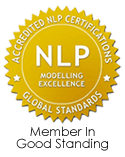NLP Practitioner Certification Level
A. Duration of Training: Minimum of 120 hours of training in the basics of NLP patterns taught by a Certified Trainer, or a certified Master Practitioner under the supervision of a trainer.
B. Demonstration of ability to identify the following basic skills, techniques, patterns and concepts of NLP and to utilize them competently with self and with others.
1. Behavioral integration of the basic presuppositions of NLP, including:
- Outcome orientation with respect for others’ models of the world and the ecology of the system. (Respect each person’s model of the world)
- Distinction between map and territory. (The map is not the territory)
- There is only feedback -no failure. (All outcomes are achievements; there is only feedback)
- Meaning of your communication is the response you get.
- Adaptive intent of all behavior. (Every behavior is motivated by positive intention. People make the best choices they can with the resources they have available.)
- Everyone has the necessary resources to succeed. (Individuals have all of the resources they need to achieve their desired outcomes.)
- Resistance is a signal of insufficient pacing. (Effective communicators accept and utilize all communication presented to them.)
- Law of requisite variety. (The element in a system that has the most flexibility will be the catalyst of that system)
2. Rapport, establishment and maintenance of
3. Pacing and Leading (verbal and non verbal)
4. Calibration (sensory based experience)
5. Representational systems (predicates, and accessing cues)
6. Meta-Model
7. Milton-Model
8. Elicitation of well-formed, ecological outcomes and structures of present state
9. Overlap and Translation
10. Metaphor creation
11. Frames; contrast, relevancy, As If, Backtrack
12. Anchoring (VAK) Visual, Auditory, Kinesthetic
13. Anchoring Techniques (contextualized to the field of application)
14. Ability to shift consciousness to external or internal, as required by the moment’s task
15. Dissociation and Association
16. Chunking
17. SubModalities
18. Verbal and non-verbal elicitation of responses
19. Accessing and building of resources
20. Reframing
21. Strategies; detection, elicitation, utilization, & installation
22. Demonstration of behavioral flexibility
Note: In addition to the basic requirements to meet the Global Standards of NLP Practitioner Certification, Life Potential Developments includes Certification in Time-based Techniques, Humanistic Neuro Linguistic Psychology and Life Coach Certification within the NLP Training Online program. All four certifications (NLP Practitioner, Time-base Techniques Practitioner, Humanistic Neuro-Linguistic Psychology Practitioner & Life Coach) are included in your investment.
